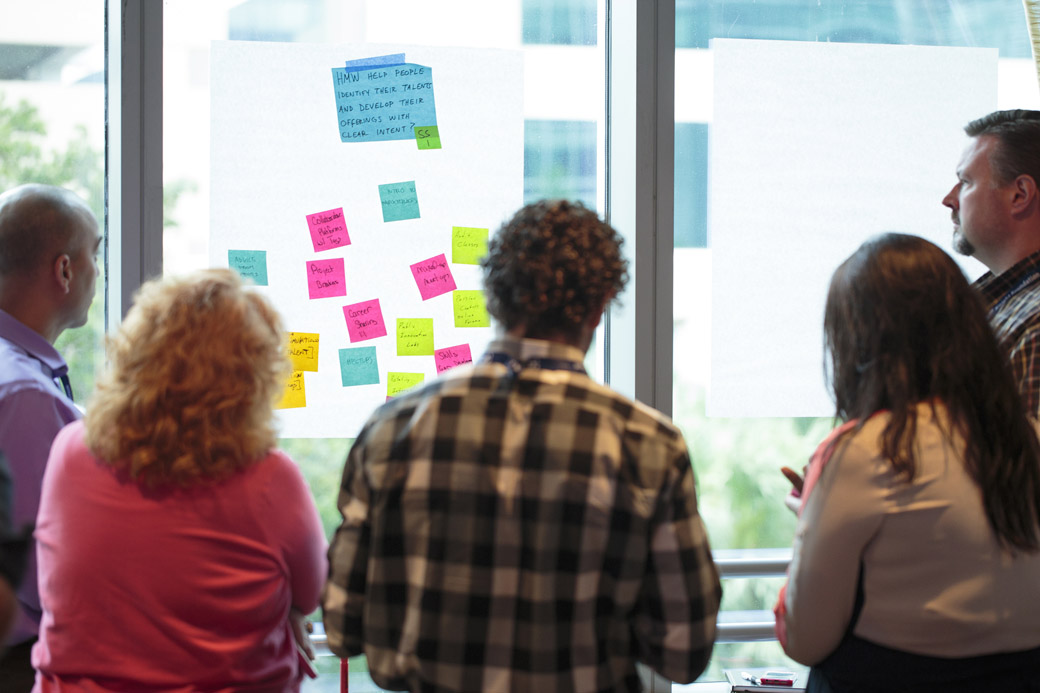
Studio produces trove of ideas to improve civic engagement
Photo credit: Tom Clark.
Overview: Knight Foundation hosted 100 civic innovators at a Civic Innovation in Action Studio in Miami May 12 -14 to explore ways to harness talent, advance opportunity and promote robust engagement.
Participants in the “Robust Engagement” discussion at the Civic Innovation in Action Studio produced five remarkably concrete ideas to drive civic participation.
The ideas crystalized during the second and final day of the session, after the participants largely took control of the idea-generating process to leverage their expertise. The ideas ranged across the spectrum from foundational research to plug-and-play civic action, with a psychology experiment in between. RELATED LINKS
“Putting ideas into action to build better cities” by Carol Coletta on KnightBlog
“Learning Lab gathers ideas on promoting community engagement” by Carol Coletta on KnightBlog
“Learning Lab gathers ideas on making the most of talent in our cities” by Carol Coletta on KnightBlog
“Innovators develop ideas on advancing opportunity” by Michael Bolden on KnightBlog.org
“Boston adopts new tools to engage residents in civic life” by Nigel Jacobs on KnightBlog
“Scaling an Etsy Economy for a changing workforce” by Dana Mauriello on KnightBlog
“Harriet Tregoning, identifying ideas to expand opportunities in cities” by Carol Coletta KnightBlog
“Encouraging more robuts acts of citizenship” by Adam Royalty and Scott Witthoft on KnightBlog
“Studio explores ideas for successful cities” by Carol Coletta on KnightBlog
“Civic innovators gather in Miami to build ideas for successful cities” by Michael Bolden on KnightBlog
“Innovators embrace broad themes of robust engagement” by Andrew Sherry on KnightBlog
“Studio developing ideas on harnessing talent of a changing workforce” by Anusha Alikhan on KnightBlog
What does “social contract” mean to you?
On the research side of the spectrum, one team advocated stepping back to an elemental starting point: an extensive study to understand how today’s Americans view the social contract.
While “social contract” traditionally means the relationship between the state and the governed, the discussion that surrounded the proposal showed how different 21st century America is from Rousseau’s 18th century France. Citizenship, participants noted, is potentially defined in relationship to neighbors, organizations, corporations, local government and more, not just the central government.
“That’s why we need to do the research,” said one of the group members, in response to the complexity. “We keep saying we should meet people where they are, but we don’t know where they are.”
The group suggested the research could be a foundation for the construction of a long-term “civic infrastructure” that could counter the effects of demographic tensions over time.
Why engage?
Another group concentrated on defining the “why” and “how” of robust civic engagement, to create a scaffolding that anyone – from individuals to neighborhoods to cities – could use to enter the arena and measure results. They concluded that civic engagement should:
· Enable people to participate in decisions that affect them
· Mediate uncertainty
· Put more eyes on the street and draw on the wisdom of crowds
· Generate trust and cooperation
· Address historic inequality
· Strengthen individual agency and collective efficacy
In terms of “how,” they saw a civically engaged person as going through a cycle of becoming aware, accepting, acting and advocating – and starting over again. The first step, they stressed, is identifying the goal of the engagement.
Experiment: What makes you give a damn?
One of the most elegant ideas was an experiment to test what drives people to become engaged, particularly for the first time. The concept:
1. Start with Maslow’s hierarchy of needs: safety, love, esteem, etc.
2. Write scripts based on each need. Use the scripts in telephone calls inviting people to attend a civic meeting.
3. Tally results. Call and survey recipients for additional data.
The focus on underlying motivation makes sense, they argued, because it does not change in the way other factors do.
Designing guidelines for engagement
The purpose of identifying motivations, of course, is to change behavior. When behavior is changed lastingly, the theory goes, then it changes culture. That was the basis for another idea, combining research and action.
The loop that can change behavior and boost engagement is to inspire, equip, act – and repeat. For example, celebrating an action can inspire another one, with the goal of, say, turning an occasional voter into a regular voter.
The group advocated reinforcing this model by mining case studies of engagement for examples of inspiring, equipping and acting, and putting what is learned from both research and action into “guidelines for robust civic engagement,” designed to be clear, accessible and practical.
Civic action menu
Closing out the spectrum was a group that focused strictly on action, steering clear of research. They jokingly called themselves “Civic Polygamists” because they weren’t wedded to any single theory of change.
Instead, they developed a suite of plug-and-play strategies “designed to meet people where they are, online or off.” Practitioners can select whichever options seem most useful for their situation, for example:
· A new resident welcome kit
· Neighborhood lunch roundtables
· Crowdsource “good-spotting”
· Crowdsource and communicate neighborhood norms
· Neighbor profiles
· Community assets map
· Community health rating
· Stories of engagement
These activities could become gateways to robust engagement, the group said.
Andrew Sherry is vice president of communications at Knight Foundation.
Recent Content
-
Community Impactarticle ·
-
Community Impactarticle ·
-
Community Impactarticle ·


